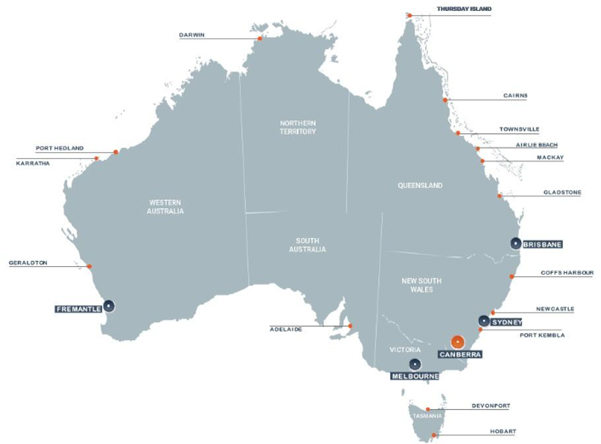Purpose of this report
Australia has one of the world’s largest mixed-market economies and is the largest continental landmass surrounded by water. Australia’s national livelihood depends on ensuring that maritime trade to, from and around the country remains safe and compliant with all relevant international conventions. Australia relies on sea transport for most of its imports and exports by weight. The Australian Maritime Safety Authority’s robust port and flag State control processes are an essential element in ensuring the safe operation of all vessels, the protection of the marine environment, and protecting seafarers and passengers' onboard vessels.
This report will be used to assist in our data driven, risk-based approach to compliance, and the data will be considered as part of producing the next National Compliance Plan.
This report summarises the inspection activities of AMSA, detailing the performance of commercial shipping companies, flag States, Recognised Organisations (ROs), Accredited Marine Surveyors (AMS) and vessel types.
AMSA is a statutory authority established under the Australian Maritime Safety Authority Act 1990 (the AMSA Act).
AMSA’s principal functions are:
- promoting maritime safety and protection of the marine environment
- protecting life at sea by enforcing the safe operation of ships
- preventing and combatting ship-sourced pollution in the marine environment
- providing infrastructure to support safety of navigation in Australian waters
- providing a national search and rescue service to the maritime and aviation sectors.
To meet public expectations, AMSA is empowered to perform compliance and enforcement functions, regulating maritime trade in Australia through the implementation of rigorous flag State control (FSC) and port State control (PSC) regimes. The inspection of Domestic Commercial Vessels is carried out under the National Law Act 2012 and the inspection of Regulated Australian Vessels (RAVs) and Foreign Flagged ships is carried out under the Navigation Act 2012. Professional and consistent FSC and PSC regimes are essential in ensuring vessels comply with the minimum standards of maritime safety, seafarer welfare and protection of Australia’s 34,000 1 kilometer coastline (excluding approximately 8,000 islands) from environmental damage
AMSA works in close cooperation with Australian state authorities, the International Maritime Organization (IMO) and PSC partner nations across the Asia-Pacific and Indian Ocean regions, sharing information and actively participating in international policy development. These efforts are aimed at ensuring AMSA remains a transparent, trusted and consistent member of the maritime community, both nationally and internationally.
As the flag State for Australian ships, AMSA is responsible for maintaining the operational safety standard of Australian-registered ships, wherever in the world they may be operating. AMSA undertakes the inspection of Australian ships in Australia and overseas (when these ships do not regularly call at Australian ports).
As the information related to AMSA’s inspection activities is used by a diverse range of stakeholders on a regular basis, AMSA delivers this information via the AMSA website (amsa.gov.au). This includes current shipping trends and emerging issues. We also detail and promulgate government regulations and important information through marine orders and marine notices, respectively. Australia is a member of both the Asia-Pacific and Indian Ocean Memorandum of Understandings (Tokyo MOU and IOMOU) and all PSC information can be found in their databases. This includes ship detentions and ongoing PSC activities.
Office locations

Footnotes
1 https://www.ga.gov.au/scientific-topics/marine/coasts-estuaries